Two weeks before her first performance as Hamlet, Michelle Terry is launching into the Dane’s most famous soliloquy in rehearsals at Shakespeare’s Globe in London. At this point a group of teenagers, on a tour of the theatre, happen to burst in. Their eyes widen. Here is the theatre’s new actor-manager doing “To be or not to be” right on its stage. When the speech finishes, the group – and others scattered around the auditorium – seem to let out a collective breath. Terry grins.
Right now, Terry has her hands full. Not only has she taken over as artistic director following Emma Rice’s contentious and high-profile departure, but she is also kicking off her opening season by playing Hamlet and taking a role in As You Like It, which will play alongside the tragedy. They’re performed back to back in an epic opening on 17 May. There’s a lot riding on this double-bill.
Both plays were written around 1599, the year the original Globe was built, and despite their differences in tone they share the themes of vicious kings and absent fathers. The plays were paired by the Royal Shakespeare Company in 2013. This time, both will be performed by Terry’s new Globe ensemble. Although there are two designated directors, Federay Holmes and Elle While, the idea behind the ensemble is to encourage what Terry calls a “real sense of ownership” over the work from everyone involved.
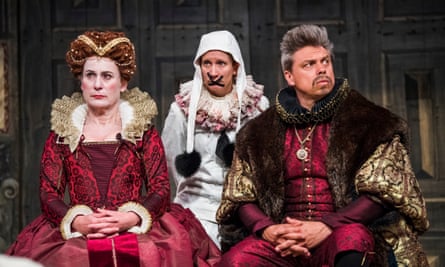
A lot of things have surprised her about the process, particularly “how reluctant people have been to work as an ensemble: an internal reluctance, from actors, to genuinely believe they have a right to talk about the costumes, for example, and believe their opinion matters”.
I spent time with the ensemble to see what happens in a rehearsal room when everyone has a say on everything. It is made up of 12 actors, all of whom were chosen before any decisions were made about who would take which roles. This has led to a number of gender-swapped characters including Shubham Saraf as Ophelia, Jack Laskey as the already gender-bending Rosalind, and Terry as the elderly servant Adam in As You Like It, and the titular role in the Bard’s most famous play.
Of her casting, Terry tells me she “never thought” she would play Hamlet. “It’s a miracle of a play and a miracle of a role so all I can do is try and enjoy and embrace the endeavour … It’s enormous, but best to start as we mean to go on.” She believes Hamlet productions can, even without meaning to, have a hierarchical structure based around the leading actor. But if the play is staged in a double-bill where “you’re all taking on different bits” then “suddenly you are genuinely egalitarian and democratic”.
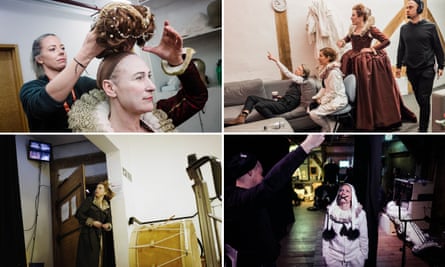
At 12 weeks, the rehearsal period is long, culminating in two tech weeks (not quite dress rehearsals, more in-costume planning to decide how and where the actors move on the Globe’s open-air stage). It’s cold during the Hamlet rehearsal I see, with the actors wearing tracksuits under their costumes, but As You Like It’s takes place on one of the warmest days of the year.
Terry is the mother of a 16-month-old who, one afternoon during tech, toddles around the stage in front of yet more tourist groups. The ensemble are following a nursery-friendly schedule, working from 11am to 5pm, which designer Ellan Parry calls “quietly revolutionary”. Terry acknowledges that maybe the 11am starts “were too late, because the amount of work that has had to happen” but adds that “it creates a focus, and you can get quite a lot done”.

On my first day watching the ensemble at work, a couple of weeks into rehearsals, I see a lot of people doing a lot – all at once. Choreographer Siân Williams leads a warm-up before the cast run scenes from Hamlet and play around with racks of clothes in a corner. Parry sketches and works on a laptop, while composer James Maloney is tinkering on a keyboard. At times the plays’ two directors work apart, one focusing on individual actors, the other with the group.
There are frequent discussions about the shape of both plays, with two British Sign Language interpreters enabling deaf actor Nadia Nadarajah to be fully involved in the room and, later, on the stage. “For my characters, Cecilia and Guildenstern, we had to work out what kind of language those characters would use,” Nadarajah says . “In As You Like It, Rosalind and Celia have grown up together. They would have a specific way of communicating with each other, a style that would only be recognisable to those two.”

Over time, the rapport among the ensemble has meant “the interpreters have become, in a way, brilliantly obsolete because I’m able to get by without them”, Nadarajah adds. She says the ensemble has been working with three languages – Shakespeare’s English, modern English and BSL, which the hearing actors integrate into their performances. Over the rehearsals, I see the cast working together to decide on signs, with Hamlet at first becoming the sign for bacon, a play on Denmark.
The conversations around costumes have been similarly collaborative. Parry says that, mostly for reasons of practicality, “there’s usually an onus on a designer and a director to come up with a concept before the actors are even cast”. The ensemble process, in contrast, has involved each actor having a separate conversation with Parry about their costume, allowing them to “be a lot bolder and wilder”. The outfits have been put together from the Globe’s costume store as Terry wanted to celebrate the theatre’s history. Parry says the process has involved “a lot of snatching time. I’ve always felt like the hanky in a bizarre eight-way tug of war. In order to respond to what’s going on I need to be in the room, but in order to deliver I need to be out of the room doing fittings and stuff. But the resources and the will were there.”
Composer James Maloney was similarly “unnerved” by the ensemble’s way of working, at least at first. “Normally in a job you turn up on the first day of rehearsals and you have your songs ready and you teach them, and then you move on.” This time, he started with nothing, the music being composed during the rehearsal period. Nonetheless, it sounds fantastic. In the Hamlet tech rehearsal, as the cast perform the moment Polonius watches the play-within-a-play, the scene is silent apart from booming, brass-heavy music. “It’s been really invigorating and enormously exciting, even at its most stressful points,” Maloney says.
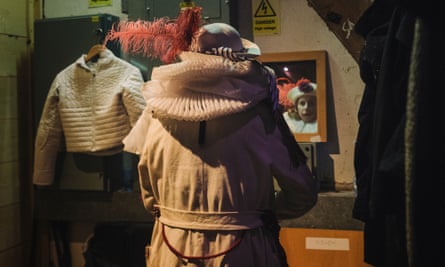
This spirit of collaboration may well influence the Globe’s relationship with its audiences. Terry observes that “there’s a lot of money made out of telling people, ‘You don’t understand Shakespeare, let us help you understand it.’” She is keen for the theatre to become more of a public space. The Globe’s cause, she says, is “Shakespeare’s transformative impact on the world” but they have a duty to both serve and question that cause. “Is it really having a transformative impact on the whole world?” she asks. “Or is it, at the moment, still certain demographics that have access to it?”
Watching the tech rehearsals, sitting on the benches at the Globe, it is easy to get caught up in the magic of the space. Farah Karim-Cooper, head of higher education and research at the Globe, tells me that the ensemble are “trying to go back to the sort of organic process of creating a play in the way that Shakespeare’s company might have worked”. Things have, in a way, come full circle. “The Globe was reconstructed and opened in 1997, just as we were on the cusp of the digital age,” Karim-Cooper continues. “Now, we decide when we want to watch something, or how involved we are in a process, something that is really a phenomenon of the digital revolution. When you come into a space like the Globe you are given licence to do that, too. No one is telling you where to look or stand, how to feel, what to think. You make that decision. I think that is what is really special about the Globe.”
- Hamlet and As You Like It are at Shakespeare’s Globe, London, until 26 August. Box office: 020-7401 9919.


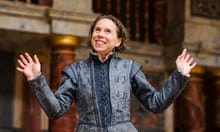





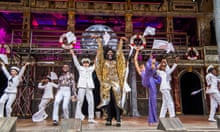

Comments (…)
Sign in or create your Guardian account to join the discussion